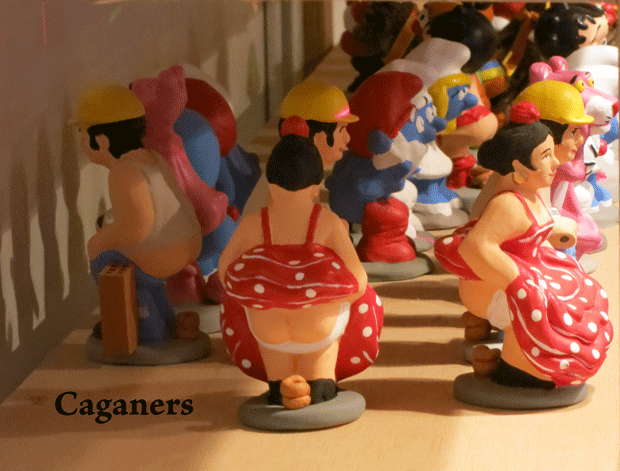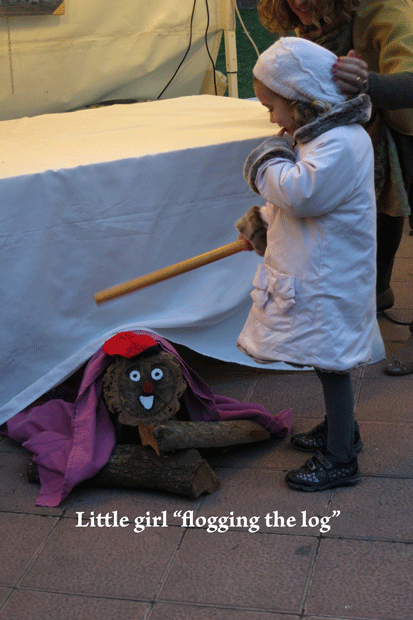Have a Happy Crappy Christmas Catalonia-Style
by Elyn Aviva
Bon Nadal and Feliç Any Nou! That’s Catalan for Merry Christmas and Happy New Year.
It’s the holiday season in my home town, Girona, Catalonia, and things aren’t quite what you might expect. Yes, there are the familiar ho-ho-ho Santa Claus figures dangling from buildings, and three-foot-high Christmas trees with matching pink and purple ribbon decorations are lined up outside stores on the main shopping streets.
There are brilliant-colored lights strung across the avenues, and a glittering conical abstraction of a Christmas tree pulses on and off in the Plaza de Catalunya. Christmas carols (sometimes in English) echo through the halls, the beauty salons, and the restaurants, and carolers emote as they stroll down the pedestrian Rambla, songbooks in hand. Flame-red poinsettias are for sale in the market, and school-club fundraisers hawk chocolate bars and handmade knickknacks. And there’s the cheery Firanadal (Christmas Fair) offering artisanal goods, felt slippers, jewelry, plastic toys, and boxwood spoons.
Yes, all of this is vaguely familiar, even if gigantes (giant dancing king and queen figures), a marathon Nativity play (Els Pastorets), xuixus (pronounced “choochoos”: sugar dusted, cream-filled pastry rolls), and turrón (a kind of nougat) aren’t usual Christmas fare.
But you really know you’re in a foreign land when you seen the rows of squatting miniature figures—including SpongeBob SquarePants, flamenco dancers, Obama, Barça soccer star Messi, Queen Elizabeth II, and Death—their pants pulled down, a brown plop of poop deposited behind them, for sale for inclusion in Nativity scenes. Correction: the plop of poop behind Death is white, not brown.
These are the famous Caganers, a peculiar and unique feature of Catalan Nadal. In 2005, the Barcelona City Council forbade the inclusion of the Caganer in the city-sponsored Nativity scene, claiming a recent by-law made public defecation and urination illegal. The public outcry was enormous; people saw this as an attack on Catalan traditions. So in 2006 the crapping Caganer was restored to its place of honor. In 2010, a 19-foot-tall defecating giant graced the Maremagnum Shopping Center in Barcelona, Spain. It won the Guinness World Record for largest Caganer. One has to wonder how much competition there was.
The origin of Caganers is unknown, but they are recorded as a vital part of the Nativity scenes in Catalonia by the late seventeenth or early eighteenth century. Although most popular in Catalonia and neighboring areas where Catalan culture is strong (Andorra, Valencia, Northern Catalonia—i.e., southern France), they also appear in Murcia, in southern Spain; in Portugal; and in Naples, in southern Italy. Whether enthusiastic Catalans brought them there or they spread by contagion is unknown. They even have their own association, The Friends of the Caganer (http://www.caganer.com).
At any rate, in Catalonia, the Pessebre (Catalan for Nativity scene) is a pastoral scenario based around a traditional Catalan farmhouse. It usually includes the infant Jesus in the manger, Mary and Joseph, the three Wise Men (more on them later), shepherds, angels, women at daily tasks (washing clothes, spinning), water wheels, wells, etc. And the Caganer, discreetly tucked away but eagerly sought for.
Why have a figure excreting waste in a holy Nativity scene? The answer is anybody’s guess, and many people have. Suggestions include: humor; a funny spectacle for children; the physiological equality of all people; symbolically fertilizing the earth, which was important in rural culture, and thus ensuring the health and happiness of the community; reinforcing the idea that the infant Jesus is God in human form; the insertion of the mischievous “other” in the midst of a holy scene as “leavening”; and so on.
Nor are the Caganers the only indication that something unusual is going on in the minds and hearts and customs of Catalans. They also have the intriguing habit of flogging a log (Tió). Catalan children flog the Tió de Nadal or Caga Tió (“shit log”) and sing a song, and the flogged log “craps” candy and nuts in response. Unless, of course, the Tió is chocolate, in which case it is struck much more gently. The end result (pardon the pun) is still the same: gifts falling from an unseen orifice into waiting hands.
The tradition in Catalonia—and in neighboring Catalan-influenced areas like Occitania in France and Aragon in Spain—is that beginning on December 8, the Feast of the Immaculate Conception, the Tió appears in the dining room. “He” is a hollow log “standing” on little log legs, painted with a smiling face, and wearing a red cap, similar to the traditional Catalan barretina. He must be fed and cared for daily by the children in the family, who cover him with a cloth or blanket at night to keep him warm. Apparently this teaches the children something (I’m not sure what) about responsibility. In some families the initial Tió is tiny but, if he is well fed, he gradually grows into a much larger Tió, presumably capable of crapping bigger gifts.
If the children do a good job of caretaking, on Christmas Eve the Tió is supposed to give back to them. They beat it with sticks and sing a version of the following catchy ditty in Catalan:
Shit log,
shit turrón (nougat),
hazelnuts and cottage cheese,
if you don’t shit well,
I’ll hit you with a stick,
shit log!
A different version goes,
Shit log,
log of Christmas,
don't shit herrings,
which are too salty,
shit nougats (turrón)
which are much better!
After an initial gentle beating, by the end the children are flogging the log more fiercely and chanting, “Caga Tió!” At the climax, someone reaches under the cloth or blanket and finds nuts, turrón, candies, and perhaps dried figs deposited at the rear end of the log.
The original Tió was a rough, natural log, perhaps 12” long, and it would be placed in the fireplace hearth and commanded to “shit.” In recent years, the Tió has been “prettified” or “humanized,” decorated with an idiotic face and pencil-thin legs. And now, since there are few fireplace hearths, he has lost his association with that source of heat and light.
Let’s take a deep breath and contemplate these peculiar activities. Maybe more is going on than reveling in bodily functions. Perhaps the same impulse connects the Caganer and the Tió: the importance of fertility, expressed by human figures whose “crap” fertilizes the fields and by a part of nature (a tree trunk) that “craps” human food.
Lest you think the entire Catalan Christmas season revolves around excrement, I should mention the Cavalcada de Reis (The Horseback Procession of The Magi), which occurs on January 5, the day before Epiphany/Twelfth Night. The Three Kings and numerous attendants (including jugglers, fire-eaters, scribes, bakers, cooks, and bearers of gifts) parade through the streets, tossing gifts and candy to the people who line the sidewalks. Then the Three Kings return to their encampment on the hillside above the medieval city walls. At home, parents traditionally have given important gifts on this day rather than on Christmas. The Procession of the Three Kings is, however, a Catholic European tradition, not a uniquely Catalan one like the crapping log and the Caganer.
So if you happen to hear someone talking about “having a crappy Christmas,” just smile and wish them “Bon Nadal.”
Elyn Aviva is a transformational traveler, writer, and fiber artist. Her blog is www.powerfulplaces.info. Currently living in Girona (Catalonia), Spain, she is fascinated by pilgrimage and sacred sites. Her PhD in anthropology was on the modern Camino de Santiago in Spain. Aviva is author of a number of articles, books, and novels on pilgrimage and sacred sites. She is co-author with her husband, Gary White, of the series “Powerful Places Guidebooks.” The most recent one is Powerful Places in Wales. To learn more about these publications, go to www.powerfulplaces.com and www.pilgrimsprocess.com. To learn about Elyn’s fiber art, go to www.fiberalchemy.com.











